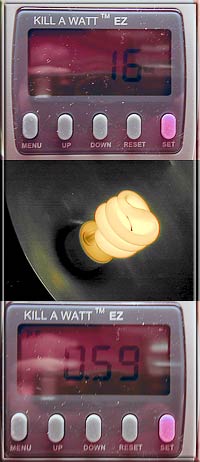

The Kill A Watt — ≈ $27 at Costco — is a sophisticated electricity measuring device that, when placed between an electrical load and the alternating current power source, measures voltage, current, watts, and even calculates the cost of operating an applicance. And in the photographs to the left, it’s reporting that the 13-watt compact fluorescent lamp (CFL) being tested isn’t quite the energy saver that we’ve been led to believe.
Let’s begin with the CFL. Manufactured by Feit, it’s an Energy Star product, rated at 13 watts and 900 lumens, and sold as a replacement for a standard 60-watt incandescent light bulb producing approximately the same amount of light (a Phillips 60-watt soft white bulb is rated at 860 lumens, for example). Although the CFL costs more to purchase, it lasts much longer than the incandescent bulb and, for the CFL’s owner, costs one-fourth as much per hour to operate. Where electricity prices are high, it’s life cycle cost is lower than the life cycle cost of incandescent bulbs — and it saves energy.
The rub is that substituting the 13-watt Feit CFL for a 60-watt incandescent bulb doesn’t reduce your electrical utility’s load by 47 watts. The utility’s load is reduced, but by only 33 watts.
How is this possible? Because (a) the Feit CFL actually draws 16 watts, which is 23 percent more than the CFL’s nameplate rating, and (b) the CFL’s ballast has a power factor of only 59 percent. By comparison, an incandescent bulb’s power factor is, for all practical purposes, 100 percent. A more sophisticated, and expensive, ballast could bring a CFL’s power factor up to 90 percent.
Now, you’re wondering, what is a power factor? Here’s how the Wikipedia defines it:
The power factor of an AC electric power system is defined as the ratio of the real power flowing to the load to the apparent power, and is a number between 0 and 1 (frequently expressed as a percentage, e.g. 0.5 pf = 50% pf). Real power is the capacity of the circuit for performing work in a particular time. Apparent power is the product of the current and voltage of the circuit. Due to energy stored in the load and returned to the source, or due to a non-linear load that distorts the wave shape of the current drawn from the source, the apparent power can be greater than the real power.
In an electric power system, a load with low power factor draws more current than a load with a high power factor for the same amount of useful power transferred. The higher currents increase the energy lost in the distribution system, and require larger wires and other equipment. Because of the costs of larger equipment and wasted energy, electrical utilities will usually charge a higher cost to industrial or commercial customers where there is a low power factor.
Utilities deliver volt-amperes of power, but customers pay for watt-hours of power. If the power factor is less than 100 percent, the utility delivers more current than the customer’s electrical device converts to work. According to my Kill A Watt, the Feit CFL is using 16 watts, but 27 volt-amperes are being delivered to the circuit. That makes the CFL an energy-saver compared to an incandescent bulb with comparable light output, but there’s a lot of room for improvement.
Another good example is the 4-inch fan on my desk. With a power factor of 51 percent, it draws 17 watts and 34 volt-amperes. I also tested a Feit 23-watt CFL (26 watts, 60 percent), a Feit 15-watt reflector flood CFL (15 watts, 62 percent), and a Lights of America 1.5-watt LED bulb with an edison base (3 watts, 46 percent). I’m not sure how accurate the Kill A Watt is with very small loads, so the LOA LED might have a higher power factor.
By comparison, my six-year-old Macintosh computer has a power factor of 87 percent, and my portable air conditioner does even better at 96 percent. These are big ticket items, so the cost of power factor correction circuitry is only a small fraction of the overall cost.
The problem of low CFL power factors is not a issue of technology. We know how to make CFLs with much high power factors. It is, rather, the consequence of not having a regulatory requirement for higher power factors. For in the absence of such a requirement, competitive pressures conspire to degrade the quality of the product.